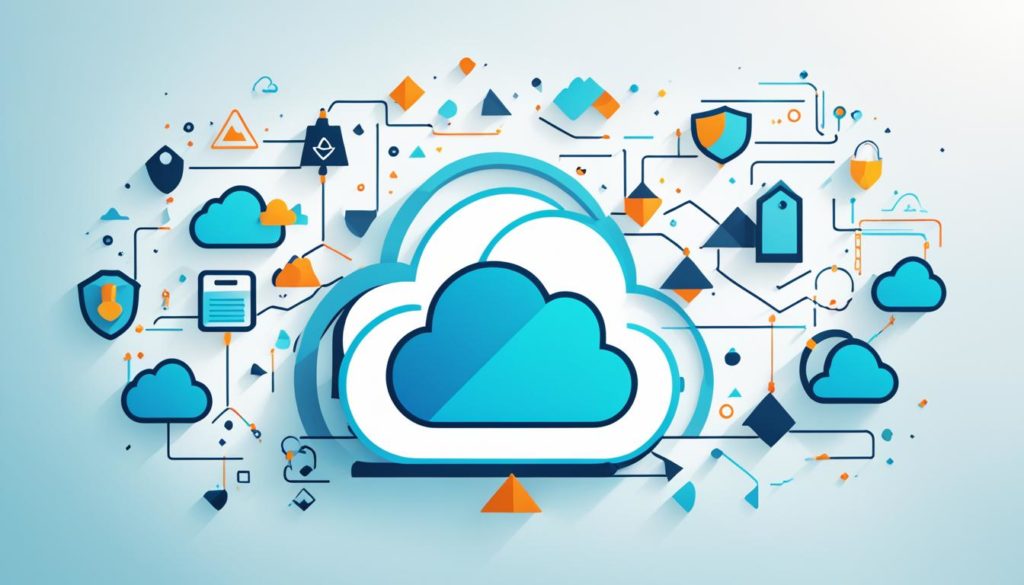
In today’s world, filled with digital growth, a noteworthy forecast emerges. By 2023, the global public cloud services market is expected to reach an impressive $597 billion. This shows the rapid expansion of cloud technology. It highlights how vital it is for communication, storage, and management. We start our exploration of cloud computing at this crucial point in tech evolution. Here, information isn’t stored in our devices but in the vast cloud.
The journey into cloud computing simplifies its core concepts for us. Imagine a future without bulky hardware or large server rooms. Instead, the cloud offers smooth, scalable solutions. We’re at the edge of a major change. It will bring better collaboration, increased productivity, easier disaster recovery, cost efficiency, and scalability. We’re going to look into how we keep, get, and handle our data. We’ll explore major frameworks like Infrastructure as a Service (IaaS), Software as a Service (SaaS), and Platform as a Service (PaaS). These are the foundations of the massive cloud services world.
Let’s explore the critical parts of cloud computing. The market for it is growing quickly and is accepted by many industries. We’ll reveal the main points of cloud tocomputing basics. We’ll see not only what it can do but also the real advantages it offers for work and everyday life.
Key Takeaways
- Global cloud services market is rapidly growing, estimated to reach around $597 billion in 2023.
- Cloud technology facilitates remote storage, access, and real-time collaboration, reducing the reliance on physical servers.
- An understanding of cloud computing basics, including IaaS, PaaS, and SaaS, is essential for leveraging the benefits of cloud services.
- Cloud adoption contributes to significant cost savings, scalability, and improved disaster recovery for diversified industries.
- Introduction to cloud computing offers a practical gateway into the necessities and advantages of cloud-based solutions.
Embracing the Era of Cloud Technology
The move to cloud computing is changing everything about business. It’s a big step away from old-school IT setups. Now, companies can work better, save money, and adapt quickly to new challenges.
One of the biggest wins of using the cloud is spending less money on IT. Companies don’t need their own data centers anymore. This means they can cut down both upfront costs and the money spent keeping things running. Plus, they can easily change how many resources they use, only paying for what they need.
The cloud also makes working together a lot easier. People can get to their data and work together no matter where they are. This is perfect for teams spread out around the world or those working from home.
| Feature | Benefits |
|---|---|
| Cost Efficiency | Reduces capital and operational expenditures |
| Scalability | Flexible resource allocation based on demand |
| Collaboration | Enables real-time, global teamwork and data sharing |
| Operational Efficiency | Improves resource management and service delivery |
| Rapid Elasticity | Quick adaptation to business needs with minimal downtime |
Adopting cloud computing means more than just new tech. It’s about changing how we handle IT. Cloud features like instant service, wide network use, and quick changes help businesses. This isn’t just a trend; it’s a major shift that brings real benefits. It leads to better business growth and service.
Understanding Cloud Computing Basics
Welcome to the world of cloud computing. It’s reshaping how we use technology and do business. Cloud technology offers easy solutions unlike traditional IT setups, making data easy to manage and access.
Definition and Core Characteristics
Cloud Computing Basics show us that it provides computing services online—like storage and software. It’s efficient and reduces costs by pooling resources. You only pay for what you use, moving away from costly traditional IT.
The Evolution from Traditional IT to the Cloud
Moving to cloud-based technology has been a big change. It fixes old issues like high costs and complex upkeep. Cloud tech is more streamlined and affordable, helping all kinds of businesses access advanced computing without much hassle.
Companies like Amazon Web Services and Google Compute Engine offer powerful and tailored computing resources. They handle storage, data processing, and computing power for you.
Demystifying IaaS, PaaS, and SaaS
It’s key to understand the different cloud services. IaaS gives you control over your IT via virtual tech. It’s great for managing big data without the hardware costs. PaaS helps developers build and manage apps easily without stressing over infrastructure. SaaS delivers ready-to-use applications online, making it super popular.
For a deep dive, check out introduction to cloud computing.
Here’s something interesting: by 2021, 94% of computing will happen in the cloud. This shows how traditional data centers are becoming less important.
| Service Model | Provider | Core Benefits |
|---|---|---|
| IaaS | Amazon Web Services, Google Compute Engine, Microsoft Azure | Flexibility, cost-effectiveness, scalability |
| PaaS | Google App Engine, AWS Elastic Beanstalk | Streamlined application development, none infrastructural concerns |
| SaaS | Salesforce, Microsoft Office 365 | Accessible from anywhere, lower upfront costs |
Cloud computing offers huge benefits like scalability and efficiency. This shift to cloud services is crucial in our digital world. By using IaaS, PaaS, and SaaS, businesses can cut costs, boost productivity, and spark innovation.
Navigating Through Cloud Services and Providers
Today, it’s key to know how to find your way among cloud service providers. Amazon Web Services, Microsoft Azure, and Google Cloud lead the way with their powerful services. Let’s look closer at what they offer and what to think about when picking the best one for you.
Assessing the Top Cloud Computing Providers
When looking into cloud services, Amazon Web Services, Microsoft Azure, and Google Cloud are top dogs because of their wide range of services and big impact. Amazon Web Services is known for its huge system that can grow with your business needs. It’s perfect for companies needing big cloud solutions. Microsoft Azure works great with Microsoft products which helps if you already use Microsoft software. Google Cloud is the go-to for strong analytics and machine learning, key for today’s apps.
Key Factors in Selecting a Cloud Service
Choosing the best cloud service means thinking about what matters most for your goals. Here are the important things to consider:
- Scalability: A cloud service must adjust its resources based on your changing needs. This adapability is crucial for your growth and avoiding service issues.
- Costs: It’s important to look at the costs and possible savings on infrastructure. Keeping an eye on expenses is vital for your profit in the long run.
- Security: With more data breaches, picking a cloud provider that offers top security and meets regulations is a must to keep your information safe.
- Availability and Disaster Recovery: Choosing services with high availability and good disaster recovery ensures your operations stay up and data stays safe, even during problems.
Knowing these aspects and how each provider matches them can help you make a smarter choice. This will make sure your organization uses cloud services that truly meet your needs.
The Pillars of Cloud Infrastructure
Cloud infrastructure stands at the forefront of tech progress today. It’s built on crucial elements like data centers and virtualization. Knowing how these parts fit together helps us understand cloud effectiveness and growth potential.
The importance of data centers in cloud tech is huge. These places do more than just hold computers. They’re where data is processed and managed. By handling these tasks well, data centers ensure that cloud services are reliable and always available.
Virtualization turns one physical computer into many virtual ones. This makes the most of hardware and adds flexibility. It lets different virtual systems operate at the same time but apart from each other, boosting security, cutting costs, and allowing for growth as needed.
The cooperation between these two key parts supports the strength of cloud infrastructure. By layering virtualization over physical servers in data centers, resources are used well and computing power is matched perfectly with the tasks at hand.
For a closer look at making the most of these technologies, check out the four core aspects of cloud engineering from Nitor Infotech. They cover strategy, migration, and running cloud services, which are vital for creating customized cloud solutions.
Using advanced data centers and virtualization, companies can be faster and more dynamic. As we keep adopting these techs, we’ll see big changes in data management and service delivery. This opens the door for new, adjustable cloud solutions that keep up with digital changes.
Cloud Computing Deployment Models Explained
Understanding cloud computing’s deployment models is key for choosing the best solution for our business. Each model has unique benefits for different business needs and rules.
Public vs. Private vs. Hybrid Clouds
Cloud computing has three main strategies: public, private, and hybrid clouds. The public cloud is run by outside companies and is great for businesses that want to grow without spending a lot. The private cloud gives more security and control, perfect for firms with strict rules.
The hybrid cloud mixes both, offering flexibility. It lets companies enjoy the advantages of the public and private clouds together.
Matching Business Needs to Deployment Strategies
Finding the right cloud model depends on our business goals. Whether we’re after saving money, keeping data safe, following rules, or scaling up, there’s a model for every requirement.
| Cloud Type | Main Advantage | Ideal for |
|---|---|---|
| Public Cloud | Cost Efficiency | Start-ups and small to medium businesses |
| Private Cloud | Enhanced Security | Organizations with strict data security and privacy needs |
| Hybrid Cloud | Flexibility | Businesses looking for a balance between scalability and control |
Securing Your Data in the Cloud
Exploring cloud computing shows cloud security and data privacy as top needs. The benefits of cloud computing include more than ease and scalability. They offer vital security features to keep important info safe in today’s tech world.
Understanding Cloud Security Measures
The CIA triad—Confidentiality, Integrity, and Availability—lies at the heart of cloud security. This triad combines to secure the cloud. Confidentiality sees that only approved people access sensitive info through strong access controls. Integrity ensures the data is trustworthy and correct. Availability means authorized users can access data and services any time.
Security also means using top-notch encryption techniques for data protection, whether stored or sent. Unauthorized users find it hard to crack this data. Cloud services often check their security to find weaknesses. They make sure they follow rules like GDPR, which improves data privacy and safety.
Best Practices for Ensuring Data Excellence and Security
To increase cloud security, providers and users must follow best practices. Important steps include using strong passwords, multi-factor authentication, and frequent data backups. These steps lessen the chance of security issues happening.
It’s also key to keep up with new cloud security developments. Data Loss Prevention (DLP) tools are essential for avoiding data leaks and losses. These tools monitor and protect data by stopping threats and blocking unauthorized access. Such measures are very important in CI/CD settings, where changes can open up new risks.
| Security Feature | Function | Impact on Data balance |
|---|---|---|
| Access Controls | Restrict data access to authorized users | Enhances confidentiality and integrity |
| Encryption | Secures data at rest and in transit | Prevents unauthorized data decryption |
| Regular Security Audits | Identifies and mitigates vulnerabilities | Ensures compliance and fortifies security |
In conclusion, keeping our data safe in the cloud requires teamwork. Cloud providers, customers, and security experts must all play their part. By knowing and applying the best practices, we ensure our data stays guarded. This lets us enjoy all the great benefits of cloud computing.
Conclusion
Cloud technology has become vital in today’s digital world. It brings many benefits that make operations smooth and help growth. We learned that using the cloud brings major benefits. It lets businesses grow and makes it easy for people to work together and be creative.
Success in the cloud starts with knowing the basics and choosing the right services. It’s also about putting the right solutions in place. Keeping our data safe in the cloud is crucial. With these tips, we’re ready to use cloud tech to its full potential, helping different fields advance.
Cloud computing is more than a trend; it’s changing how we use technology and data. The move to the cloud marks a new digital age. As we look ahead, we’re confident cloud tech will keep leading innovation. It will keep us ready for future challenges with flexible and strong solutions. Let’s all be part of this exciting evolution, using the cloud wisely and strategically.
FAQ
What are the basics of cloud computing?
Cloud computing serves up computing resources like storage and software through the internet. This means you can innovate faster, use only what you need, and scale your business as it grows. It’s all about using the internet to lower costs and become more efficient.
What are the benefits of cloud technology?
Cloud technology saves money, scales easily, and flexes with your computing needs. It boosts teamwork, improves disaster recovery, and lets you launch apps more securely and quickly.
How does cloud computing differ from traditional IT infrastructure?
Unlike traditional IT, cloud computing doesn’t need on-site hardware or data centers. This cuts costs. It also allows for more flexibility and efficient computing thanks to shared services.
What are IaaS, PaaS, and SaaS?
IaaS provides online computing resources. PaaS offers internet-based tools for app development. SaaS gives internet access to software, usually with a subscription.
Who are the top cloud computing providers?
Amazon Web Services (AWS), Microsoft Azure, and Google Cloud lead the cloud computing scene. They offer various services and have a big global presence to meet computing and business needs.
What should I consider when selecting a cloud service?
Think about service scalability, cost vs. in-house infrastructure, security, the provider’s reliability, and how it fits with your current systems.
What is cloud infrastructure?
Cloud infrastructure includes the necessary hardware and software, like servers, storage, networking, and virtualization, to support cloud computing.
What’s the difference between public, private, and hybrid clouds?
Public clouds serve many customers. Private clouds are for one organization. Hybrid clouds mix both, sharing data and apps between them.
How do I match my business needs to a cloud deployment strategy?
Choose based on control level, security, compliance, scalability, and budget. Public, private, and hybrid clouds offer different advantages for your business and tech needs.
What are cloud security measures?
Cloud security includes firewalls, encryption, detection systems, and authentication. Providers follow standards and regulations to protect data privacy and integrity.
How can I ensure data security and excellence in the cloud?
Ensure security by picking a reputable provider, using strong passwords, enabling authentication, backing up data, and setting clear security policies.
Future App Studios is an award-winning software development & outsourcing company. Our team of experts is ready to craft the solution your company needs.










